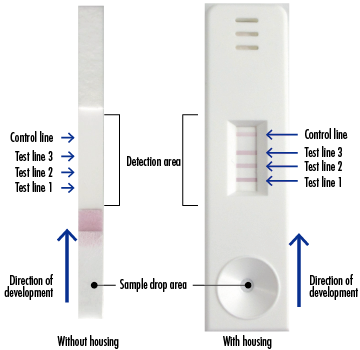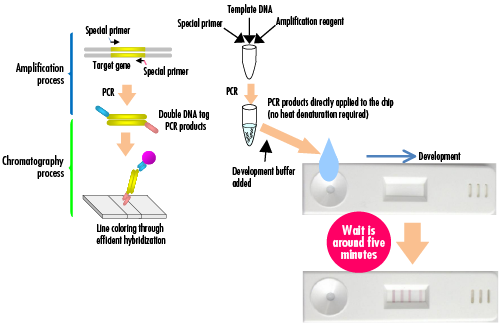Home > Highlighting JAPAN > Highlighting Japan MARCH 2013 > Easy Detection of Multiple Genes
Highlighting JAPAN
[SERIES] SCIENCE & TECHNOLOGY
Easy Detection of Multiple Genes
Genetic technologies are applied in a wide variety of areas in addition to biology, including clinical testing, detection of allergic substances and criminal investigations. Genes are so minuscule and imperceptible that until now they could not be tested or analyzed without special equipment. However, a revolutionary system with a simple kit that paves the way for quick visual observation of multiple genes has recently been commercialized. Takashi Sasaki reports.

Exterior Views of Kaneka's Genetic Detection Chips for Nucleic Acid Chromatography
A pink belt comes out on the test strip for each gene to be detected easy visual identification of multiple genes.
Credit: COURTESY OF KANEKA CORPORATION
"Among the four different DNA bases, A and T complement each other, as do G and C. For this reason they always form pairs. We have invented a chip for nucleic acid chromatography by capitalizing on this property of DNA," explains Shigehiko Miyamoto from the Frontier Biochemical & Medical Research Laboratories in Kaneka Corporation, a major general chemical manufacturer based in Osaka.
The genetic testing method Kaneka has developed is outlined as follows. First, tissue of an animal or plant or a sample of a bacterium or cell is taken. Then, the multiplex polymerase chain reaction (PCR) method is implemented to amplify a trace amount of DNA. The PCR products are mixed with development fluid and the mixture is dropped onto and permeated into a test chip. A pink belt then appears on part of the chip to indicate the existence of DNA to be detected.
It previously took at least an hour to detect multiple genes at one time so specific DNA was separated by a method that takes advantage of an electric charge of electrophoresis from a sample amplified in the multiplex PCR before dyeing and ultraviolet irradiation for identification. In contrast, only about five to ten minutes are required with the use of the newly developed test chip. Depending on the chip setting it is possible to detect more than one gene at a time. This method requires no special device such as an electrophoresis tank or ultraviolet irradiator.

Theory and Usage
Credit: COURTESY OF KANEKA CORPORATION
From Kaneka's New Business Development Department, Takaoki Saneyasu described the advantage of this new genetic testing system.
"Conventionally, genetic testing required special equipment, and we had to bring samples back to research institutions and elsewhere, and take time analyzing them," he says. "With this chip for nucleic acid chromatography, we can make a determination even at a hospital bedside. The system will help identify the causes of food poisoning and infectious diseases, make decisions on whether or not to administer medication for which the effect varies depending on the patient's genes, carry out cancer diagnoses, and perform cell tests in regenerative medicine very quickly."
In detecting multiple genes at the same time, the chip for nucleic acid chromatography is highly convenient for testing of food-borne allergens. It also enables food factories to easily check for the presence of transgenic crops. The chip was fully commercialized for professional use in November 2012. It is attracting great expectations from medical professionals in developing countries that are inadequately equipped with genetic testing facilities and from many different industrial domains around the world.
© 2009 Cabinet Office, Government of Japan






